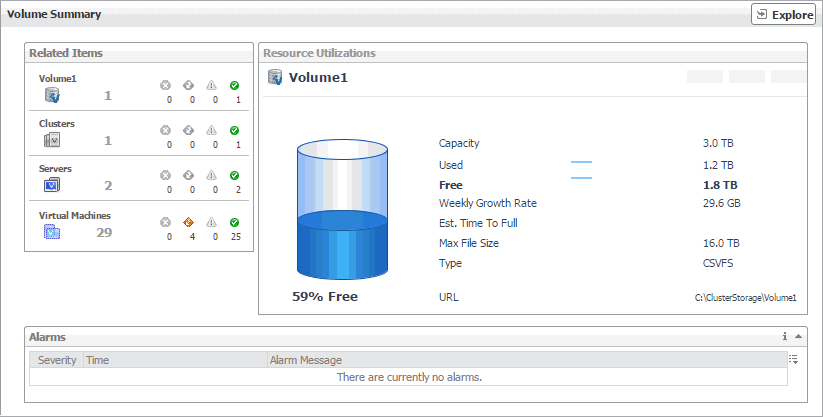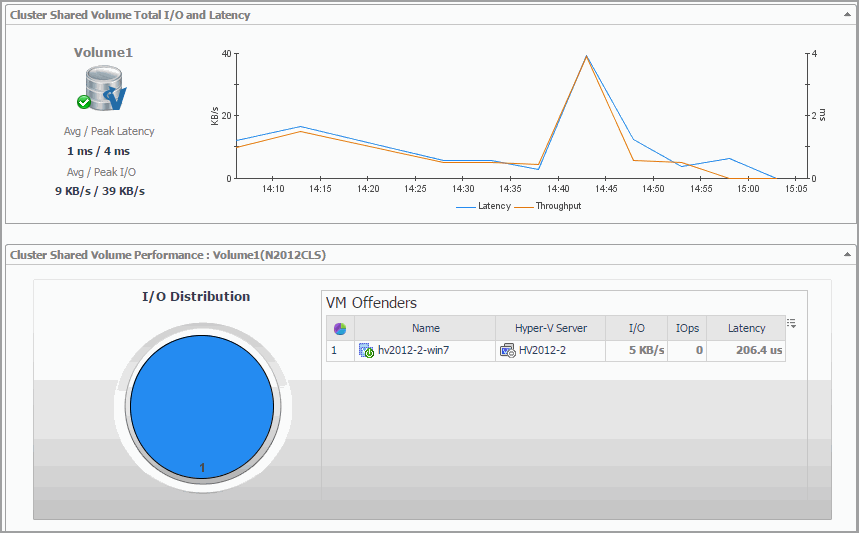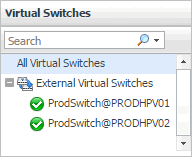Volume Summary view
The Volume Summary view shows the levels of resource utilization and consumption for a selected volume.
This view appears in the display area when you select a volume in the Summary - All Storage view.

This view is made up of the following embedded views:
|
|
Shows the selected volume and other components associated with it in your virtual infrastructure. |
|
|
|
• |
Clusters. The number of clusters associated with the selected volume, followed by the related alarm counts. | |
|
|
|
• |
Servers. The number of servers associated with the selected volume, followed by the related alarm counts. | |
|
|
|
• |
Virtual Machines. The number of virtual machines that are associated with the selected volume, followed by the related alarm counts. | |
|
|
|
• |
Volume. Represents the selected volume. Shows the counts of the alarms generated against the volume. | |
|
|
Drill down on: |
|
|
|
• |
Clusters. Displays the Clusters dwell, showing the names and states of all clusters that are associated with the selected volume. |
|
|
|
|
• |
Server. Displays the Servers dwell, showing the names and state of the servers associated with the selected volume. |
|
|
|
|
• |
Virtual Machines. Displays the Virtual Machines dwell, showing the names and states of all virtual machines that are associated with the selected volume. |
|
|
|
|
• |
Volume. Displays the Other Items Inventory dwell, showing the state of the selected volume. |
|
|
|
Shows the resource consumption for the selected volume. |
|
|
|
• |
Capacity. The total amount of volume space, including free and used space. | |
|
|
|
|
|
|
• |
Free. The amount of volume space that is available for use. | |
|
|
|
|
|
|
• |
Percent Free. The percentage of volume space on the that is available for use. | |
|
|
|
• |
Type. The file system on the selected volume. | |
|
|
|
• |
URL. The URL to the selected volume. | |
|
|
|
• |
Used. The amount of volume space that is currently in use. | |
|
|
|
• |
Volume. The name of the selected volume, followed by the related alarm counts. | |
|
|
|
• |
Weekly Growth Rate. The projected amount of the volume space that becomes in use on a weekly basis. | |
|
|
Drill down on: |
|
|
|
• |
Free or Used. Displays the Logical Drive Utilization dialog box. |
|
|
|
|
Volume view
The Volume view shows the data transfer rates and latency detected for the selected volume. It also identifies the virtual machines that use the highest amounts of the volume resources.The information provided on this tab can help you prevent potential bottlenecks by reallocating disk resources where they are most needed.
This view appears in the display area when you click  in the Volume Summary view.
in the Volume Summary view.

This view is made up of the following embedded views:
Virtual switch monitoring
A Hyper-V Virtual Switch is a software-based layer-2 Ethernet network switch. The switch connects virtual machines to virtual and physical networks.
To review data collected about a specific volume or all volumes, make your selection in the Quick-View.
Virtual Switches view
The Virtual Switches tree view lists the available volumes and indicates their severity state.
This view appears in the Quick-View on the left when you select the Virtual Switches tile in the Virtual Environment view.

Selecting the All Virtual Switches node displays the overall resource utilization for all virtual switches in your integrated system and identifies the ones that consume the highest amount of network resources in the Summary - All Virtual Switches view on the right. Similarly, selecting a virtual switch node shows switch-specific metrics in the Summary - Virtual Switch view.
|
|
|
• |
Alarm severity. The state of the most recent alarm raised against the virtual switch. | |
|
|
|
• |
All Volumes. A parent node for the instances of all virtual switches that appear in this view. | |
|
|
|
• |
Volume. The name of the virtual switch. | |
|
|
Drill down on: |
|
|
|
|
|
|
in the Volume Summary view.